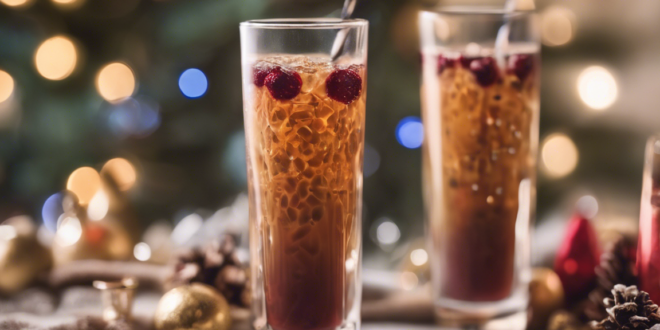Festive Sips and Calories: Navigating Holiday Drink Choices with Nutrition in Mind
As the holiday season unfolds, our favorite seasonal beverages become more than just drinks – they’re cherished traditions that warm our hearts and elevate our festive spirits. From creamy eggnog to peppermint-infused lattes, these indulgent libations are as much a part of the holiday experience as twinkling lights and family gatherings. However, beneath their delightful flavors lies a complex nutritional landscape that can significantly impact our health and wellness goals.
The Hidden Calories of Holiday Beverages
Most holiday drinks are culinary masterpieces of indulgence, designed to tantalize our taste buds while simultaneously challenging our nutritional resolve. A typical grande Starbucks Peppermint Mocha, for instance, packs a whopping 440 calories and 54 grams of sugar – nearly equivalent to the daily recommended sugar intake for an entire day. This single beverage represents more than just a momentary pleasure; it’s a nutritional challenge that can derail carefully maintained dietary balance.
Breaking Down Popular Holiday Drink Profiles
Understanding the nutritional composition of popular holiday drinks is crucial for making informed choices. Let’s explore some beloved seasonal beverages and their nutritional implications:
Eggnog: The Classic Holiday Indulgence
Traditional eggnog is a rich, creamy concoction that embodies holiday decadence. A single 8-ounce serving typically contains approximately 350 calories, 19 grams of fat, and 20 grams of sugar. While delicious, this beloved drink is essentially liquid dessert, combining heavy cream, eggs, sugar, and often alcohol. For those watching their caloric intake, consider lighter versions or homemade alternatives that utilize skim milk and natural sweeteners.
Seasonal Coffee Drinks: More Than Just Caffeine
Specialty coffee drinks like peppermint mochas, gingerbread lattes, and caramel brulee beverages are marketing marvels that transform simple coffee into liquid celebration. However, these drinks are nutritional landmines. A standard 16-ounce flavored latte can contain up to 50 grams of sugar and 400 calories. Registered dietitians recommend opting for smaller sizes, requesting sugar-free syrups, and choosing non-fat milk to dramatically reduce caloric content.
Alcoholic Holiday Beverages: Calories in Celebration
Alcoholic holiday drinks present another layer of nutritional complexity. A typical mulled wine contains approximately 250 calories per glass, while festive cocktails like White Russians or spiked hot chocolate can range from 300-500 calories. The combination of alcohol, sugar, and cream creates a perfect storm of potential weight gain and metabolic challenges.
Strategies for Mindful Holiday Drinking
Enjoying holiday beverages doesn’t mean complete deprivation. Instead, it requires strategic approach and moderation. Here are expert-recommended strategies:
- Choose smaller portion sizes
- Request sugar-free or reduced-sugar options
- Alternate alcoholic drinks with water
- Consider homemade versions with controlled ingredients
- Practice mindful consumption
Healthier Alternatives and Modifications
Modern nutrition emphasizes adaptability. Many favorite holiday drinks can be reimagined with healthier ingredients. For instance, replace whole milk with almond or oat milk, use stevia instead of sugar, and incorporate natural spices like cinnamon and nutmeg for flavor without additional calories.
Nutritional Mindfulness Without Sacrifice
The goal isn’t to eliminate holiday enjoyment but to create a balanced approach. By understanding nutritional content and making informed choices, individuals can savor seasonal beverages while maintaining wellness goals. Remember, occasional indulgence is part of a healthy lifestyle – it’s about overall balance, not perfection.
Practical Tips for Holiday Beverage Enjoyment
1. Read nutrition labels carefully
2. Practice portion control
3. Choose quality over quantity
4. Stay hydrated with water
5. Consider the overall daily nutritional intake
Conclusion: Celebrating Wisely
Holiday drinks represent more than mere beverages; they’re cultural experiences that connect us to traditions and memories. By approaching them with knowledge and mindfulness, we can enjoy these seasonal delights without compromising our health and wellness objectives. The key is informed choice, moderation, and the understanding that nutrition is a journey of balance and enjoyment.
 Good Calories Guide GoodCalories Guide focuses on nutrition, healthy eating, and overall wellness. The site offers practical insights into evidence-based dietary practices, including tips for specific lifestyles such as veganism, keto, and family-friendly meal planning. It also addresses unique nutritional needs for individuals with conditions like diabetes or food allergies, while providing quick and accessible recipes to make healthy living a sustainable and enjoyable choice.
Good Calories Guide GoodCalories Guide focuses on nutrition, healthy eating, and overall wellness. The site offers practical insights into evidence-based dietary practices, including tips for specific lifestyles such as veganism, keto, and family-friendly meal planning. It also addresses unique nutritional needs for individuals with conditions like diabetes or food allergies, while providing quick and accessible recipes to make healthy living a sustainable and enjoyable choice.


